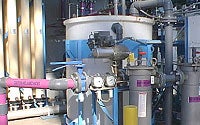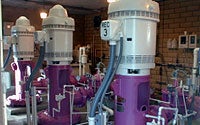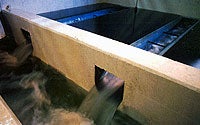Recycled Water Quality
Both the North City and South Bay water reclamation plants produce high-quality recycled water. A series of treatment and purifying steps, employing the latest technologies, ensures the end product meets or exceeds all state and federal guidelines.
Horticultural and Industrial Users Recycled Water Quality Report
2025 North City Water Reclamation Plant Reports
2025 January (North City)
2025 February (North City)
2025 March (North City)
2025 April (North City)
2025 May (North City)
2025 June (North City)
2025 July (North City)
2025 August (North City)
2025 September (North City)
2025 October (North City)
2025 South Bay Water Reclamation Plant Reports
2025 January (South Bay)
2025 February (South Bay)
2025 March (South Bay)
2025 April (South Bay)
2025 May (South Bay)
2025 June (South Bay)
2025 July (South Bay)
2025 August (South Bay)
2025 September (South Bay)
2025 October (South Bay)
Report Archives
Please see the Recycled Water Quality Archives
Components Present in Recycled Water

Following is a description of the components present in recycled water.
- Total Dissolved Solids (TDS): Are any substances that exist as a solid when dry, dissolves completely in water and cannot be easily filtered. For example: ordinary table salt would make up part of the TDS value if it were dissolved in water. Water that has a TDS of under 1000 (parts per million) is considered to be appropriate for agricultural use, and can be used for many industrial purposes.
- Chloride, Sodium, Calcium, and Magnesium, are all found in your water. They are present in different types of salts and make up a portion of the TDS total count.

- Water Hardness, measured as equivalents of calcium carbonate (CaCO3), is present in water that is imported from the Colorado River. It is part of the limestone that came from the Colorado River gorge. Hardness shows up on your dishes as water spots. The amount of hardness found in recycled water can be less than the amount of hardness found in drinking water.
- Alkalinity, HCO3, is the opposite of acidity. The alkalinity or acidity of water is measured by testing the pH of the water. A pH reading of 7.0 is considered to be neutral, a lower pH reading indicates a more acidic environment and a higher pH indicates an environment which is alkaline. Human stomach acid has a pH of about 4, baking soda a pH of about 10.

- Potassium and Nitrogen are present in recycled water in slightly higher levels than in potable water. Both potassium and nitrogen are valuable nutrients for plants. The use of recycled water often reduces the amount of fertilizer required to grow agriculture.
- Boron can be present in recycled water in small amounts. It is a by product that remains in water even after treatment when nonbiodegradable detergents and soaps have been used. The use of environmentally friendly detergents and soaps will reduce the amount of boron present in recycled water.
- Residual Chlorine will be present in water which has been treated with chlorine. Chlorine is used in recycled water as a protection against bacteria.
- Adjusted Sodium Adsorption Ratio (SAR) is a measurement of how sodium can be deposited from water to the soil. With normal rain fall and watering the SAR levels in recycled water are considered to be acceptable for most agricultural use.
- Turbidity is a measurement of the clarity of water. Turbidity in water can be affected by any number of fine particles such as dust.
- Coliforms are used as an indicator of bacterial contamination. Coliforms themselves do not cause any illness.

